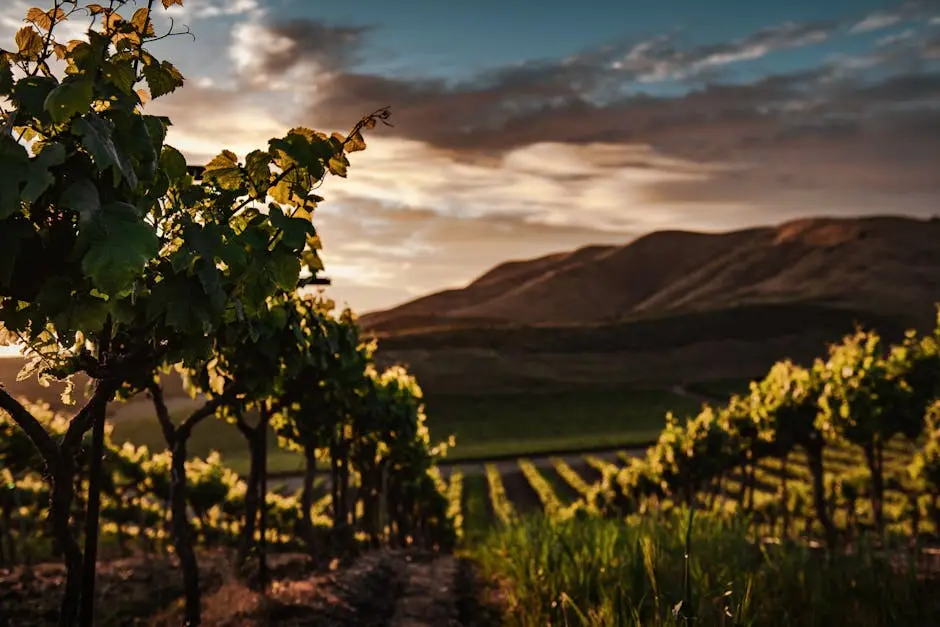The Sierra Foothills is a fascinating region that produces unique red wines, greatly influenced by its climate. In this FAQ, we’ll explore how different climatic factors shape these wines, making them distinctive in taste and quality.
What makes the Sierra Foothills climate unique?
The Sierra Foothills experience a Mediterranean climate with hot, dry summers and mild, wet winters. This combination creates an ideal setting for growing certain red grape varieties, impacting their growth cycles and flavor profiles. This climatic feature is what sets the region apart from many other wine-growing areas in California Sierra Foothills AVA Explained.
In the Sierra Foothills, the climate not only nurtures the grapevines but also contributes to the region’s charm. The hot summer days accelerate sugar development in the grapes, essential for the bold, fruity flavors found in red wines. Meanwhile, the cool nights are a vital element, preserving the grapes’ natural acids and delaying ripening, which enhances the grace and elegance of the wines produced here Tasting Room | Lecavalier Cellars.
How does temperature affect the grapes?
Temperature plays a crucial role in grape ripening. Warm days in the Sierra Foothills help in developing sugars in grapes, while cooler nights preserve acidity, balancing sweetness and creating a desirable complexity in red wines. This diurnal temperature variation ensures that the wines have a vibrant yet balanced flavor profile Join Our Wine Club.
The magic of red wines often lies in the delicate balance of sugar and tartness, a harmony struck perfectly in the Sierra Foothills. As the sun bathes the vineyards in golden light, grapes soak up the heat, gradually sweetening their juice. But when the day wanes and the cool breeze sweeps in, this natural air conditioning steers the acidity into a refined sharpness, a trademark of fine wine from the area Wise Villa Winery.
What role does elevation play in wine quality?
The elevation of vineyards affects sunlight exposure and temperature variations. Higher elevations often lead to more intense sunlight, enhancing color and tannin structure in red wines, while cooler temperatures slow ripening, promoting aromatic compounds. The vineyards of Sierra Foothills take full advantage of diverse elevations to create an array of flavors in their wines Sierra Foothills AVA Explained.
Vineyards perched on the slopes of the Sierra Foothills benefit from the unique climatic interplay of sun and shade. As you ascend the elevations, the shifts in temperature and light turn into an artful dance, yielding grapes that tell the tale of their terroir. These subtle yet powerful influences result in wines of exceptional character and richness, a testament to nature’s hand in winemaking Sierra Foothills AVA.
With elevation comes a more nuanced complexity in wines. As opposed to lower grounds, the high-altitude vineyards expose grapes to greater fluctuations in temperature; sunny days enhance the color and density of tannins, while nocturnal chills refine the aroma. Such conditions lend the wines a structural finesse and captivating aroma that are particularly cherished by wine connoisseurs Visit.
How does soil influence the flavor of red wines?
The diverse soils in the Sierra Foothills, ranging from granite to volcanic, impart distinct mineral characteristics to the wines. Soil composition affects water drainage and nutrient availability, influencing vine vigor and, subsequently, the taste of the red wines. The terroir is said to speak through the bottle, offering an authentic sip of the land’s character Sierra Foothills AVA.
Can weather variability impact the wine production?
Yes, variability in weather such as unexpected frosts or heatwaves can greatly impact grape yield and quality. These weather patterns can affect harvesting times, grape health, and ultimately the wine’s flavor profile and production volume. The ability to adapt and respond to these changes is crucial for wineries in maintaining a consistent quality and distinctive flavor in their wines Reservation.
Weather unpredictability poses both challenges and opportunities. A sudden frost might reduce yield, yet, in some instances, the difficulty can enhance certain flavor profiles, adding an extra layer of intrigue to the wine. Each vintage tells a unique story, shaped by the specific climatic conditions of that year Reservation.
Viticulture in the Foothills is an attunement to nature’s rhythms. With climate variability comes the excitement of trying to anticipate and adapt to changes, making every harvest a calculated risk. Each maneuver in the face of weather shifts could either be a stroke of genius or a humble learning for the next season—a thrilling aspect of winemaking Sierra Foothills AVA.
A Toast to Nature’s Influence
Understanding the impact of climate on red wines in the Sierra Foothills helps us appreciate the complex flavors and qualities of these wines. The region’s unique climate not only shapes the character of the wines but also offers a glimpse into the dynamic and intricate world of viticulture.



